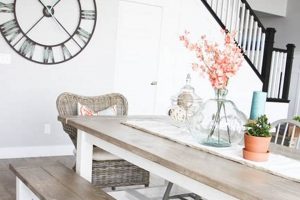A custom-built surface designed to support a Weber grill represents a practical solution for outdoor cooking enthusiasts. This structure, often incorporating storage and workspace, enhances the functionality of the grilling area. An example includes a wooden table constructed to precisely fit a specific Weber grill model, offering shelves for utensils and fuel.
The importance of such a support structure lies in its ability to optimize the grilling experience. Benefits include improved organization, a safer cooking environment due to a stable base, and an aesthetically pleasing addition to outdoor spaces. Historically, similar structures have been employed to elevate and contain cooking fires, evolving from simple stone hearths to more sophisticated designs.
The following sections will detail various design considerations, material selections, construction techniques, and safety precautions relevant to the creation of these customized grill supports. This information aims to provide a comprehensive guide for individuals seeking to build a durable and functional structure for their grilling needs.
Essential Considerations for Weber Grill Support Construction
The following guidance provides crucial points to consider when undertaking the construction of a custom Weber grill support structure. Prioritizing these aspects ensures both functionality and longevity of the build.
Tip 1: Material Selection is Paramount: Opt for weather-resistant materials such as treated lumber, cedar, or composite decking. Untreated wood will degrade rapidly, compromising structural integrity. For example, using pressure-treated pine instead of standard pine will significantly extend the table’s lifespan.
Tip 2: Precise Measurement and Fit are Critical: Accurately measure the Weber grill’s dimensions to ensure a snug and secure fit within the support structure. Excess space can lead to instability, while insufficient space may prevent proper ventilation. Develop a detailed plan based on these measurements prior to construction.
Tip 3: Prioritize Structural Stability: Employ robust joinery techniques, such as mortise and tenon, or reinforced screws and brackets, to ensure the table’s stability. A wobbly structure poses a safety hazard, particularly when supporting a hot grill. Reinforce corners and load-bearing points to prevent sagging or collapse.
Tip 4: Incorporate Adequate Ventilation: Ensure proper airflow around the Weber grill’s base to prevent overheating. Insufficient ventilation can lead to damage to the grill itself or the support structure. Consider incorporating vents or leaving open spaces around the grills sides.
Tip 5: Integrate Heat-Resistant Surfaces: If the support structure includes surfaces near the grill, utilize heat-resistant materials like ceramic tile or stainless steel. This prevents scorching or ignition of flammable materials. A tiled surface adjacent to the grill offers a safe zone for placing hot utensils.
Tip 6: Consider Mobility and Storage: Adding heavy-duty casters allows for easy relocation of the grill table. Including enclosed or open shelving provides space for storing grilling accessories, fuel, and utensils. Ensure the casters are rated for the combined weight of the table and the grill.
Adherence to these principles results in a structurally sound, functional, and aesthetically pleasing support structure for the Weber grill, enhancing the outdoor cooking experience while prioritizing safety.
These considerations lay the groundwork for the subsequent steps in the construction process, ensuring a successful and enduring outcome.
1. Material Weather Resistance
Material weather resistance represents a critical factor in the design and construction of any custom support structure intended for outdoor use, particularly those designed to house a Weber grill. The longevity and structural integrity of the resulting table depend directly on the materials’ ability to withstand environmental stressors.
- Moisture Resistance
Moisture, in the form of rain, humidity, and condensation, poses a significant threat to many common building materials. Wood, if not properly treated, can warp, rot, and become susceptible to fungal growth. Materials such as treated lumber, cedar, or composite decking resist moisture absorption, thereby extending the life of the table and preventing structural failure. For instance, using pressure-treated lumber mitigates the risk of decay in comparison to untreated pine.
- UV Radiation Protection
Prolonged exposure to ultraviolet (UV) radiation from sunlight can degrade many materials, causing them to become brittle, fade, or crack. Certain plastics and finishes are particularly vulnerable. Incorporating UV-resistant coatings or selecting materials inherently resistant to UV degradation ensures the table maintains its appearance and structural integrity over time. An example would be applying a marine-grade varnish to wooden components to protect against sun damage.
- Temperature Fluctuation Resilience
Outdoor environments experience significant temperature fluctuations, which can cause materials to expand and contract. This constant stress can lead to cracking, warping, and joint failure. Materials with low coefficients of thermal expansion, such as certain types of metal or composite materials, are better suited for these conditions. Constructing the table with materials that can withstand temperature changes minimizes the risk of structural damage. For example, using stainless steel hardware prevents corrosion and maintains its strength despite temperature variations.
- Resistance to Insect Damage
Wood-boring insects, such as termites and carpenter ants, can rapidly destroy untreated wood structures. Selecting insect-resistant materials, such as cedar or pressure-treated lumber, or applying appropriate insecticides, protects the table from infestation and prolongs its lifespan. Properly sealing all wood surfaces and joints prevents insects from gaining access. The incorporation of cedar inherently provides a natural defense against insects, reducing the need for chemical treatments.
The selection of materials with inherent weather resistance properties is not merely a cosmetic consideration; it directly impacts the safety, durability, and long-term cost-effectiveness of a grill support structure. Failure to address these factors can result in premature failure, requiring costly repairs or replacement, ultimately diminishing the value of the construction effort.
2. Precise Grill Dimensions
Accurate determination of a Weber grill’s dimensions constitutes a foundational element in the design and construction of a custom support structure. This accuracy directly influences the safety, functionality, and aesthetic integration of the grill within the overall table design. Deviation from precise measurements introduces risks of instability, inadequate ventilation, and compromised usability.
- Ensuring Structural Stability
Precise grill dimensions are critical for creating a stable and secure housing. A support structure built without accurate measurements may result in a grill that wobbles or sits unevenly. Such instability presents a safety hazard, particularly when handling hot surfaces or heavy cooking equipment. For example, a table built with a recess too large for the grill can cause the appliance to shift during use, increasing the risk of spills or accidents. Conversely, an opening too small may lead to difficulty in placing or removing the grill for maintenance.
- Optimizing Ventilation and Heat Management
Accurate dimensions enable the incorporation of proper ventilation around the grill. Weber grills require adequate airflow to function efficiently and safely. A support structure constructed with insufficient clearance can restrict airflow, leading to overheating and potentially damaging the grill or the surrounding materials. The dimensions must account for the grill’s ventilation requirements, allowing heat to dissipate effectively. For instance, side vents on the grill should remain unobstructed to ensure proper combustion and temperature control.
- Facilitating Accessibility and Usability
Precise measurements ensure convenient access to the grill for cooking and maintenance. The support structure should allow for easy opening and closing of the grill lid, as well as access to components such as the ash catcher and propane tank (if applicable). Dimensions should also consider the user’s reach and ergonomics. A table that is too high or too low can create discomfort and strain. For example, accurately determining the height of the grill surface ensures comfortable grilling without excessive bending or reaching.
- Aesthetic Integration and Design Harmony
Beyond functionality, precise dimensions contribute to a visually appealing integration of the grill within the table design. Accurate measurements allow for a seamless fit, creating a cohesive and professional appearance. Ignoring the exact contours and proportions of the grill can result in an awkward or ill-fitting structure, detracting from the overall aesthetic. For instance, meticulously matching the grill’s color and style with the materials of the table can create a unified and sophisticated outdoor cooking space.
In conclusion, the significance of precise Weber grill dimensions extends beyond mere measurement; it forms the foundation for a safe, functional, and aesthetically pleasing custom support structure. Adherence to accuracy throughout the design and construction process mitigates risks, enhances usability, and contributes to the long-term enjoyment of the grilling experience.
3. Structural Stability
Structural stability is a paramount consideration in the design and construction of a custom support structure for a Weber grill. The ability of the table to withstand anticipated loads and environmental stresses directly impacts user safety and the longevity of the structure itself.
- Load-Bearing Capacity
The primary facet of structural stability involves the table’s capacity to support the weight of the Weber grill, along with any accessories placed upon it. Insufficient load-bearing capacity can lead to sagging, deformation, or catastrophic collapse. Engineering principles dictate material selection and joint design to ensure adequate strength. For instance, a table constructed from thin, untreated lumber may fail under the weight of a cast-iron grill, whereas a structure utilizing reinforced joints and treated lumber provides a more robust and reliable support. Real-world examples include tables collapsing under the load of a filled propane tank or a fully loaded grill surface.
- Resistance to Shear Forces
Shear forces, such as those generated by moving the grill or accidental impacts, can compromise a table’s stability. Structures with weak joints or inadequate bracing are susceptible to deformation or failure under shear stress. Diagonal bracing, reinforced corners, and robust joinery techniques enhance resistance to these forces. An example would be a table with poorly constructed leg connections that buckles when the grill is pushed across the surface. Properly engineered joints and bracing, on the other hand, distribute the load and prevent localized stress concentrations.
- Environmental Resilience
Outdoor environments expose grill tables to varying weather conditions, including moisture, temperature fluctuations, and wind. Structural stability must account for the long-term effects of these factors. Moisture can weaken wood, temperature changes can cause expansion and contraction, and wind can exert significant lateral forces. Utilizing weather-resistant materials, employing proper drainage techniques, and securing the table to the ground (if necessary) enhance its environmental resilience. Examples include untreated wood rotting and collapsing under sustained moisture exposure, or a lightweight table being overturned by strong winds. Proper material selection and construction techniques mitigate these risks.
- Joint Integrity and Connection Strength
The integrity of joints and the strength of connections are crucial for maintaining overall structural stability. Weak or improperly executed joints represent points of potential failure. Techniques such as mortise and tenon, dovetail joints, or the use of high-quality fasteners and adhesives enhance joint strength. For example, a table constructed with poorly glued butt joints is likely to fail under stress, while a table employing interlocking joints and reinforced fasteners provides a more secure and durable structure. The selection of appropriate joinery methods and the quality of their execution directly impact the table’s ability to withstand loads and external forces.
These facets, when comprehensively addressed, contribute to a structurally sound and safe support system for a Weber grill. Neglecting any of these areas can compromise the integrity of the structure and potentially lead to hazardous situations, thereby highlighting the necessity of meticulous planning and execution in the construction of a custom Weber grill support structure.
4. Ventilation Adequacy
Ventilation adequacy forms a crucial component of any custom-built support structure intended for use with a Weber grill. The operational characteristics of Weber grills necessitate sufficient airflow to ensure proper combustion, prevent overheating, and mitigate the risk of carbon monoxide buildup. The design of a “weber grill diy table” must therefore incorporate considerations for ventilation to avoid compromising the performance and safety of the grilling appliance.
Insufficient ventilation within a grill support structure can lead to several adverse effects. Incomplete combustion of fuel, whether charcoal or propane, may result in lower cooking temperatures, uneven heating, and the release of harmful gases. Overheating can damage both the grill itself and the surrounding table structure, potentially igniting flammable materials. Real-world examples include wooden tables scorched or charred due to inadequate heat dissipation, and grills experiencing premature component failure due to sustained exposure to elevated temperatures. The practical significance lies in ensuring the grill operates as intended, providing consistent cooking results and minimizing safety hazards.
Addressing ventilation adequacy involves several design strategies. These include providing ample open space around the grill’s base, incorporating ventilation holes or slots in the table’s sides and bottom, and selecting materials that do not impede airflow. The challenge lies in balancing ventilation requirements with structural integrity and aesthetic considerations. A well-designed “weber grill diy table” integrates ventilation seamlessly, enhancing both the functionality and appearance of the outdoor cooking area while prioritizing the safe operation of the Weber grill.
5. Accessibility and Storage
The integration of accessibility features and storage solutions into a custom grill table significantly enhances its utility and functionality. The design should prioritize ease of use and efficient organization of grilling-related items.
- Utensil Organization and Proximity
Providing designated spaces for grilling utensils, such as spatulas, tongs, and brushes, streamlines the cooking process. Hooks, racks, or drawers located within arm’s reach of the grill prevent unnecessary movement and maintain focus on the cooking surface. A real-world example is a table incorporating a slide-out drawer specifically designed to hold grilling tools, keeping them readily available and preventing clutter. Disorganized utensils can lead to delays and potential safety hazards.
- Fuel Storage and Management
Depending on the fuel type, appropriate storage solutions are essential. Propane tanks require secure and ventilated compartments, while charcoal necessitates dry and easily accessible bins. Improper storage can lead to safety risks, such as propane leaks or charcoal becoming damp and unusable. For instance, a table design incorporating a vented propane tank enclosure ensures safe storage while providing quick access for replacement. Conversely, leaving a propane tank exposed to direct sunlight increases the risk of pressure buildup.
- Surface Area for Preparation and Service
Adequate countertop space is vital for food preparation and plating. A well-designed table should offer sufficient surface area for chopping vegetables, seasoning meats, and arranging finished dishes. Limited workspace can hinder efficiency and compromise food safety. An example is a table with a large, heat-resistant countertop surface adjacent to the grill, allowing for convenient food handling. Lack of preparation space forces the cook to use alternative, potentially unsanitary, surfaces.
- Waste Management Integration
Incorporating a waste receptacle into the table design promotes cleanliness and hygiene. A designated space for disposing of food scraps, packaging, and used grilling materials reduces clutter and minimizes the risk of attracting pests. An example is a table featuring a built-in trash bin with a lid, keeping waste contained and out of sight. Failure to provide a waste management solution results in a disorganized and potentially unsanitary grilling environment.
These considerations, when integrated thoughtfully, transform a basic grill table into a comprehensive outdoor cooking station. The result is improved efficiency, enhanced safety, and a more enjoyable grilling experience. Ultimately, effective accessibility and storage are indispensable components of a functional and well-designed custom grill table.
Frequently Asked Questions
The following addresses common inquiries regarding the design, construction, and utilization of custom-built tables for Weber grills. The information provided aims to clarify prevalent misconceptions and offer practical guidance.
Question 1: What is the optimal material for constructing a Weber grill support table intended for outdoor use?
Weather-resistant materials such as treated lumber, cedar, or composite decking are recommended. These materials exhibit superior resistance to moisture, UV radiation, and temperature fluctuations, extending the lifespan of the structure.
Question 2: How does one ensure sufficient ventilation around a Weber grill housed within a custom table?
Adequate ventilation is achieved through strategic design elements. These include providing ample open space around the grill’s base, incorporating ventilation holes or slots in the table’s sides and bottom, and ensuring that no components obstruct the grill’s existing ventilation openings.
Question 3: What precautions should be taken when storing propane tanks within a Weber grill table?
Propane tanks must be stored in well-ventilated compartments to prevent the accumulation of potentially explosive gases. The compartment should be designed to allow for easy access and secure the tank in an upright position, minimizing the risk of leaks or accidents.
Question 4: Is it necessary to use heat-resistant materials on surfaces adjacent to the grill?
Yes, surfaces near the grill require heat-resistant materials such as ceramic tile or stainless steel to prevent scorching or ignition of flammable materials. This precaution is essential for maintaining safety and preventing damage to the table structure.
Question 5: How does one determine the appropriate height for a Weber grill table?
The table height should be ergonomically suitable for the user, typically ranging from 36 to 42 inches. This height allows for comfortable grilling without excessive bending or reaching. Individual preferences may dictate slight adjustments to optimize user comfort.
Question 6: What joinery techniques are recommended for ensuring the structural stability of a Weber grill table?
Robust joinery techniques such as mortise and tenon joints, dovetail joints, or reinforced screws and brackets are recommended. These methods provide superior strength and durability compared to simpler techniques, ensuring the table can withstand the weight of the grill and other accessories.
In summary, constructing a safe and functional Weber grill table requires careful consideration of material selection, ventilation, storage, heat resistance, ergonomics, and structural integrity. Adherence to these principles ensures a durable and enjoyable outdoor cooking experience.
The following section provides a conclusion that summarizes the benefits and importance of building a DIY Weber grill table.
Conclusion
This exploration of the Weber grill DIY table underscores its significance as a practical and customizable addition to outdoor cooking spaces. Key points addressed include the importance of weather-resistant materials, precise dimensional accuracy, structural stability, adequate ventilation, and integrated storage solutions. These elements collectively contribute to a safe, functional, and aesthetically pleasing environment for grilling.
The construction of a Weber grill DIY table represents an investment in both functionality and personalization. By adhering to sound design principles and construction techniques, individuals can create a durable and efficient outdoor cooking station that enhances the grilling experience for years to come. The enduring value of such a project lies in its capacity to blend practicality with personal expression, transforming a standard grill into a focal point of outdoor living.


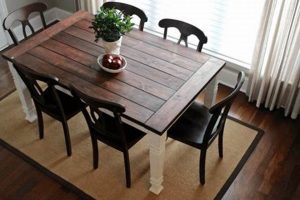
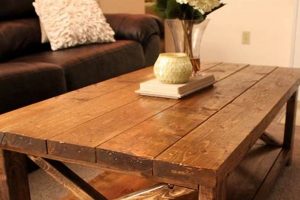
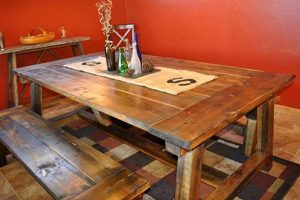
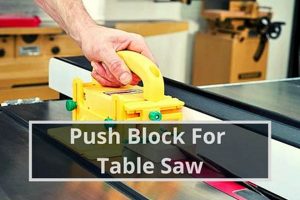
![Build a Safe DIY Table Saw Push Stick [Guide] The DIY Hub: Creative Crafts, Repairs & Life Hacks Build a Safe DIY Table Saw Push Stick [Guide] | The DIY Hub: Creative Crafts, Repairs & Life Hacks](https://craftingdiycenter.com/wp-content/uploads/2025/07/th-4323-300x200.jpg)
